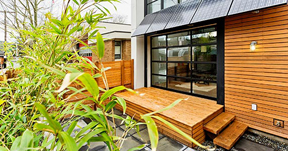 Homeowners love to make home improvements. And while kitchen and bathroom makeovers can be fun, enhancing your home’s energy efficiency can be even more enticing once you consider the benefits:
Homeowners love to make home improvements. And while kitchen and bathroom makeovers can be fun, enhancing your home’s energy efficiency can be even more enticing once you consider the benefits:
• Saving money.
• Making your home more comfortable.
• Improving the resale value.
• Reducing environmental harm.
What’s more, homeowners don’t have to choose among these attractions, says David Arkush, managing director at Public Citizen.
“We tend to think there are trade-offs and we have to decide between whether we care about the environment or we care about our own pocketbooks or convenience. Here, they go together,” Arkush says.
Energy-saving upgrades include:
• Compact fluorescent lightbulbs.
• Programmable thermostats.
• Blankets for older water heaters.
• Double-paned windows.
• Appliances that use less electricity.
• Weather-stripping around doors and windows.
•Caulking around utility pipe cut-throughs, chimneys and recessed lighting.
• Improved attic or crawl space and in-wall insulation.
The biggest benefit of an energy-efficient home is lower electricity and natural gas bills.
“A lot of these improvements make financial sense,” Cluett says. “Even though the upfront investment might cost the homeowner a bit, for a lot of them, you’ll recoup that cost and then continue saving.”
The typical U.S. household spends $2,200 per year for home utility bills, according to the U.S. Department of Energy.
Energy-efficiency savings can add up to a few hundred dollars each year for the average household, a sum Arkush describes as “not trivial.”
Weather-stripping, caulking and insulation might not have much of a wow factor, but blocking airflow is typically the most cost-effective way to make a home more energy-efficient, says Rachel Cluett, senior research analyst in the buildings program at the American Council for an Energy-Efficient Economy, a Washington, D.C., nonprofit organization that promotes energy efficiency.
“People can actually stay cool in the summer and warm in the winter in all parts of their house rather than have an issue heating or cooling that distant room,” Cluett says.
Improvements can be made at any time, though the best time might be when you’re making other renovations.
“When you already have a wall torn down and you already might have taken out financing of some kind, that’s one time when there’s an opportunity for homeowners to include energy efficiency,” Cluett says.
Several studies suggest a home’s energy efficiency matters to prospective homebuyers.
The 2013 study “What Home Buyers Really Want” by the National Association of Home Builders, included a questionnaire in which respondents ranked more than 120 elements of a home.
The top-ranked item, considered “essential” or “desirable” by 94% of the 3,682 respondents, was Energy Star-rated appliances. The 3rd-ranked item, considered “essential” or “desirable” by 91% of the respondents, was an Energy Star rating for the entire home. (The 2nd-ranked item was a laundry room.)
The July 2012 study “The Value of Green Labels in the California Housing Market” by 2 University of California economists, compared 1.6 million homes sold in the state from 2007 to 2012 and found a 9% price premium for those with an Energy Star, LEED for Homes or Green Point Rated label.
A 2013-2014 analysis of 18,605 homes sold in the Chicago area found that those that disclosed natural gas and electricity costs through the brokers’ multiple listing service sold faster, were more likely to close and received a higher percentage of the seller’s asking price.
The analysis was performed by Elevate Energy, an organization in Lisle, Illinois, that designs and implements energy-efficiency programs.
It takes a lot of dots to connect home energy to the natural environment, but the dots exist and Arkush explains how they connect.
“By making houses more energy-efficient, we’re using less power, which means less carbon goes into the air from power plants that burn coal or natural gas,” he says. “Carbon is the main greenhouse gas that’s contributing to climate change.
We already see more severe weather patterns — flooding, droughts, heavier storms, stronger hurricanes and tornadoes — and those things are already hurting property owners across the country.”
Climate change can also damage public infrastructure, causing inconvenience and higher property taxes to make repairs.
The U.S. Department of Energy says most energy supplied to residences comes from burning fossil fuels, which releases pollutants into the atmosphere.
Marcie Geffner
-Courtesy Bankrate.com






